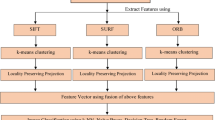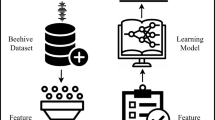Abstract
The main objective of this paper is to investigate the use of Quality Threshold ARTMAP (QTAM) neural network in classifying the feature vectors generated by moment invariant for the insect recognition task. In this work, six different types of moment invariant technique are adopted to extract the shape features of the insect images. These moment techniques are Geometrical Moment Invariant (GMI), United Moment Invariant (UMI), Zernike Moment Invariant (ZMI), Legendre Moment Invariant (LMI), Tchebichef Moment Invariant (TMI) and Krawtchouk Moment Invariant (KMI). All the moment techniques are analyzed using the concept of intraclass and interclass analysis. In intraclass analysis, several computation methods are introduced in order to examine the invariance properties of adopted moment techniques for the same insect object. Meanwhile, the classification accuracy of neural networks is adopted to measure the interclass characteristic and the effectiveness of moment technique in extracting the shape features of insect images. Other types of neural networks are also utilized in this research work. This includes novel enhancement technique based on the Gaussian and Mahalanobis function that design to increase its prediction accuracy. All the other networks used to classify the feature vectors are based on the Fuzzy ARTMAP (FAM) neural network. The experimental results indicated that the Krawtchouk Moment Invariant technique generated the highest classification accuracy for most of the networks used and generated the smallest error for the intraclass analysis. Using different normalization technique, the Quality Threshold ARTMAP and Mahalanobis distance function (QTAM-m) network gave the highest insect recognition results when compared to other networks.
Similar content being viewed by others
References
Arbuckle T, Schröder S, Steinhage V, Wittmann D (2001) Biodiversity informatics in action identification and monitoring of bee species using ABIS. In: Proceedings of sustainability in the information society, conf on environmental informatics
Affar AE, Ferdous K, Fadili HE, Qjidaa H (2009) Krawtchouk moment feature extraction for neural Arabic handwritten words recognition. In: International conference on multimedia computing and system, pp 443–448
Andonie R, Sasu L (2006) Fuzzy ARTMAP with input relevances. IEEE Trans Neural Netw 17(4):929–941
Baraldi A, Alpaydin E (2002a) Constructive feedforward ART clustering network—Part I. IEEE Trans Neural Netw 13(3):645–661
Baraldi A, Alpaydin E (2002b) Constructive feedforward ART clustering network—part II. IEEE Trans Neural Netw 13(3):662–677
Carpenter GA, Grossberg S, Markuzon N, Reynolds JH, Rosen DB (1992a) Fuzzy ARTMAP: a neural network architecture for incremental supervised learning of analog multidimensional maps. IEEE Trans Neural Netw 3(5):698–713
Carpenter GA, Grossberg S (1992b) A self-organizing neural network for supervised learning, recognition and prediction. IEEE Commun Mag 30(9):38–49
Carpenter GA, Grossberg S, Markuzon N, Reynolds JH, Rosen DB, Fuzzy ARTMAP (1992c) An adaptive resonance architecture for incremental learning of analog maps. In: International joint conference on neural networks. IJCNN, vol. 3, pp 309–314
Dai S, Huang H, Gao Z, Li K, Xiao S (2009) Vehicle-logo recognition method based on Tchebichef moment invariants and SVM. In: WRI world congress on software engineering, vol 3, pp 18–21
Dehghan M, Faez K (1997) Farsi handwritten character recognition with moment invariants. In: 13th international conference on digital signal processing proceedings, vol 2, pp 507–510
Do MT, Harp JM, Norris KC (1999) A test of a pattern recognition system for identification of spiders. Bull Entomol Res 89:217–224
Fleyeh H, Dougherty M, Aenugula D, Baddam S (2007) Invariant road sign recognition with fuzzy Artmap and Zernike moments. In: IEEE intelligent vehicles symposium, pp 31–36
Foulonneau A, Charbonnier P, Heitz F (2006) Affine-invariant geometric shape priors for region-based active contours. IEEE Trans Pattern Anal Mach Intell 28(8):1352–1357
Francoy TM, Wittmann D, Drauschke M, Müller S, Steinhage V, Marcela A, Laure FB, Jong DD, Gonçalves LS (2008) Identification of Africanized honey bees through wing morphometrics: two fast and efficient procedures. Apidologie 39(5):488–494
Gao Y, Song H, Tian X, Chen Y (2007) Identification algorithm of winged insects based on hybrid moment invariants. In: The 1st international conference on bioinformatics and biomedical engineering, pp 531–534
Gonzalez-Carrasco I, Gracia-Crespo A, Ruiz-Mezcua B, Lopez-Cuadrado JL (2009) Dealing with limited data in ballistic impact scenarios: an empirical comparison of different neural network approaches. Appl Intell
Haddadnia J, Faez K, Moallem P (2001) Neural network based face recognition with moment invariants. In: International conference on image processing, vol 1, pp 1018–1021
Heyer LJ, Kruglyak S, Yooseph S (1999) Exploring expression data: identification and analysis of coexpressed genes. Genome Res 9:1106–1115
Hu MK (1962) Visual pattern recognition by Moment invariants. IEEE Trans Inf Theory 8(2):179–187
Juan XG, Ding WR (2009) A video zero-watermark algorithm against RST attacks. In: Asia-pacific conference on information processing, vol 2, pp 15–18
Larios N, Deng H, Zhang W, Sarpola M, Yuen J, Paasch R, Moldenke A, Lytle DA, Correa SR, Mortensen E, Shapiro LG, Dietterich TG (2007) Automated insect identification through concatenated histograms of local appearance features. In: IEEE workshop on applications of computer vision, pp 26–29
Li B, Meng MQH (2008) Computer aided detection of bleeding in capsule endoscopy images. In: Canadian conference on electrical and computer engineering, pp 1963–1966
Liao SX, Pawlak M (1996) On image analysis by moments. IEEE Trans Pattern Anal Mach Intell 18(3):254–266
Mayo M, Watson AT (2007) Automatic species identification of live moths. Knowledge-Based Syst 20(2):195–202
Mukundan R, Ramakrishnan KR (1998) Moment functions in image analysis theory and applications. World Scientific, Singapore
Mukundan R, Ong SH, Lee PA (2001) Image analysis by Tchebichef moments. IEEE Trans Image Process 10(9):1357–1364
Nils H, Reinhard K, Warren A (2004) Footprint recognition of rodents and insects. Communication and information technology research technical report 149
O’Neill MA (2000) DAISY: a practical tool for semi-automated species identification. In: MacLeod N (ed) Automated taxon identification in systematics: theory, approaches, and applications. CRC Press/Taylor & Francis Group, Boca Raton/Florida, pp 101–114
Ong LY, Chong CW, Besar R (2007) An approach to 3-D object recognition using Legendre moment invariants. In: International conference on intelligent and advanced systems, pp 671–674
Potocnik B (2006) Assessment of region-based moment invariants for object recognition. In: 48th international symposium ELMAR-multimedia signal processing and communications, pp 27–32
Qing C, Petriu EM (2003) Optical character recognition for model-based object recognition applications. In: Proceedings the 2nd IEEE international workshop on haptic, audio and visual environments and their applications, pp 77–82
Radoi E, Quinquis A, Totir F (2006) Supervised self-organizing classification of superresolution ISAR images: an anechoic chamber experiment. EURASIP J Appl Signal Process 2006:1–16
Rajasekaran S, Vijayalakshmipai GA (2000) Image recognition using simplified fuzzy Artmap augmented with a moment based feature extractor. Int J Pattern Recognit Artif Intell 14:1081–1095
Rajasekaran S, Raj RA (2004) Image recognition using analog-ART1 architecture augmented with moment-based feature extractor. Neurocomputing 56:61–77
Raj PA, Venkataramana A (2007) Radial Krawtchouk moments for rotational invariant pattern recognition. In: 6th international conference on information, communications & signal processing, pp 1–5
Raveendran P, Palaniappan R, Omatu S (2000) Fuzzy ARTMAP classification of invariant features derived using angle of rotation from a neural network. Inf Sci 130(1–4):67–84
Ravi NK, Janakiraman TN, Thiagarajan H, Subaharan K (2007) Automated motion tracking of insects using invariant moments in image sequence. In: International conference on conference on computational intelligence and multimedia applications, vol 3, pp 220–224
Rizon M, Yazid H, Saad P, Shakaff AYM, Saad ARS, Mamat MR, Yaacob S, Desa H, Karthigayan M (2006) Object detection using geometric invariant moment. Am J Appl Sci 2(6):1876–1878
Ruberto CD, Morgera A (2008) Moment-based techniques for image retrieval. In: 19th international conference on database and expert systems application, pp 155–159
Sabaei M, Faez K (1997) Unsupervised classification of handwritten Farsi numerals using evolution strategies. In: IEEE region 10 annual conference speech and image technologies for computing and telecommunications, vol 1, pp 403–406
Saradha A, Annadurai S (2005) A hybrid feature extraction approach for face recognition systems. In: The international congress for global science and technology, vol 5, pp 23–30
Sheeba RJ, Devaraj D, Sukanesh R (2007) A novel feature extraction technique for face recognition. In: International conference on conference on computational intelligence and multimedia applications, vol 2, pp 428–435
Shi M, Haifeng W, Fleyeh H (2008) Support vector machines for traffic signs recognition. In: IEEE international joint conference on neural networks. IEEE world congress on computational intelligence, pp 3820–3827
Song L, Lin Y (2007) Study on the automatic instrumental reading system based on image processing. In: International conference on mechatronics and automation, pp 3870–3875
Steinhage V, Arbuckle T, Schröder S, Cremers AB, Wittmann D (2001) ABIS: Automated identification of Bee species, BIOLOG workshop. German Programme on Biodivserity and Global Change, Status Report, German Ministry of Education and Research (BMBF), Bonn, pp 194–195
Teague MR (1980) Image analysis via the general theory of moments. J Opt Soc Am 70(8):920–930
Umbaugh SE (1998) Computer vision and image analysis a practical approach using CVIPtools. Prentice Hall, New Jersey
Venkataramana A, Raj PA (2007) Image watermarking using Krawtchouk moments. In: International conference on computing: theory and applications, pp 676–680
Vigdor B, Lerner B (2007) The Bayesian ARTMAP. IEEE Trans Neural Netw 18(6):1628–1644
Watson A, O’Neill M, Kitching I (2004) Automated identification of live moths (Macrolepidoptera) using digital automated identification system. Syst Biodivers 1(3):287–300
Wee CY, Paramesran R, Takeda F, Tsuzuki T, Kadota H, Shimanouchi S (2002) Classification of rice grains using fuzzy Artmap neural network. In: Asia-pacific conference on circuits and systems, vol 2, pp 223–226
Wee CY, Paramesran R (2007) Derivation of blur-invariant features using orthogonal Legendre moments. Comput Vis 1(2):66–77
Weeks PJD, O’Neill MA, Gaston KJ, Gauld ID (1999) Species identification of wasps using principal component associative memories. Image Vis Comput 17(12):861–866
Wen C, Guyer DE, Li W (2009) Local feature-based identification and classification for orchard insects. Biosyst Eng 104(3):299–307
Wiliamson JR (1996) Gaussian ARTMAP: a neural network for fast incremental learning of noisy multidimensional maps. Neural Netw 9(5):881–897
Witten I, Frank E (2005) Data mining: practical machine learning tools and techniques, 2nd edn. Morgan Kaufmann, Los Altos
Yaakob SN, Saad P (2007) Generalization performance analysis between fuzzy Artmap and Gaussian Artmap neural network. Malays J Comput Sci 20(1):13–22
Yaakob SN, Lim CP, Jain L (2010) A novel Euclidean quality threshold ARTMAP network and its application to pattern classification. J Neural Comput Appl 19(2):227–236
Yap PT, Paramesran R, Ong S-H (2003) Image analysis by Krawtchouk moments. IEEE Trans Image Process 12(11):1367–1377
Yinan S, Liu W, Yuechao W (2003) United moment invariants for shape discrimination. In: IEEE proceedings on international conference on robotics, intelligent systems and signal processing, vol 1, pp 88–93
Yu X, Zuorui S, Seishi N (2002) Measuring geometrical features of insect specimen using image analysis. In: Conference on Asian federation information in agriculture (AFITA)
Zhang H, Shu H, Han GN, Coatrieux G, Luo L, Coatrieux JL (2010) Blurred image recognition by Legendre moment invariants. IEEE Trans Image Process 19(3):596–611
Zhang L, Xiao WW, Ji Z (2007) Local affine transform invariant image watermarking by Krawtchouk moment invariants. Inf Secur 1(3):97–105
Zhao J, Liu M, Yao M (2009) Study on image recognition of insect pest of sugarcane cotton aphis based on rough set and fuzzy c-means clustering. In: Third international symposium on intelligent information technology application, vol 2, pp 553–555
Author information
Authors and Affiliations
Corresponding author
Rights and permissions
About this article
Cite this article
Yaakob, S.N., Jain, L. An insect classification analysis based on shape features using quality threshold ARTMAP and moment invariant. Appl Intell 37, 12–30 (2012). https://doi.org/10.1007/s10489-011-0310-3
Published:
Issue Date:
DOI: https://doi.org/10.1007/s10489-011-0310-3




